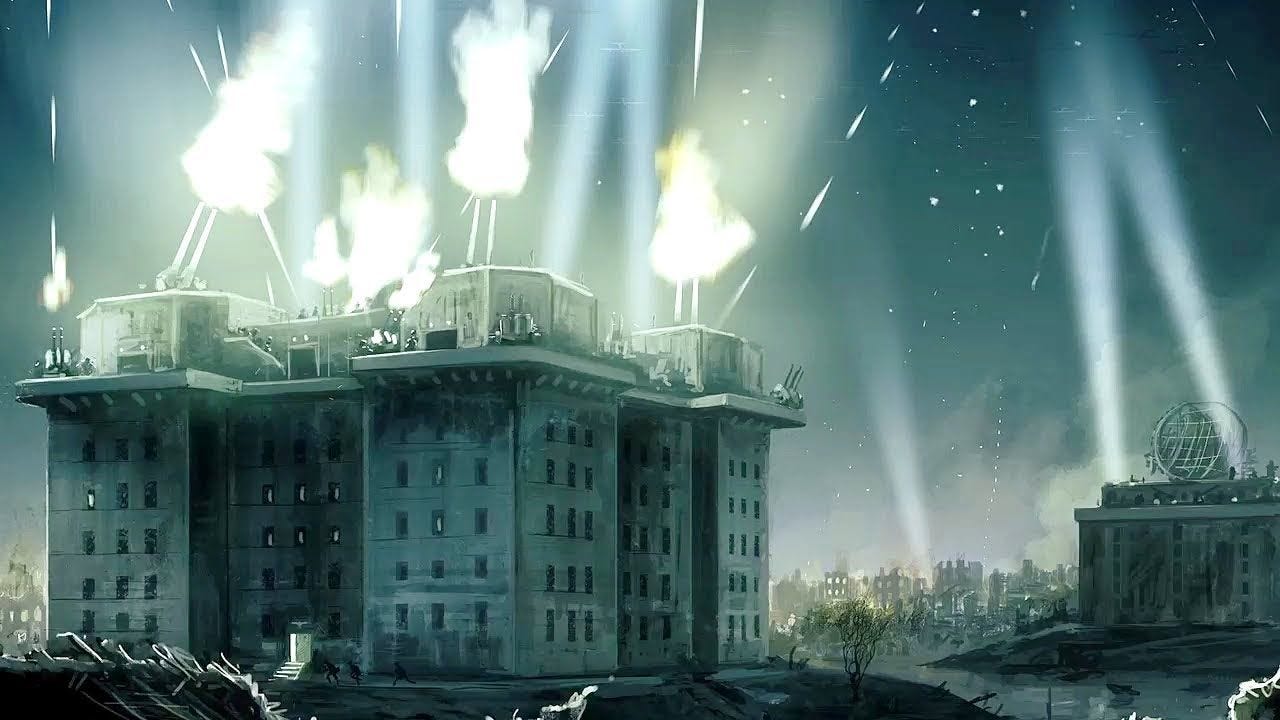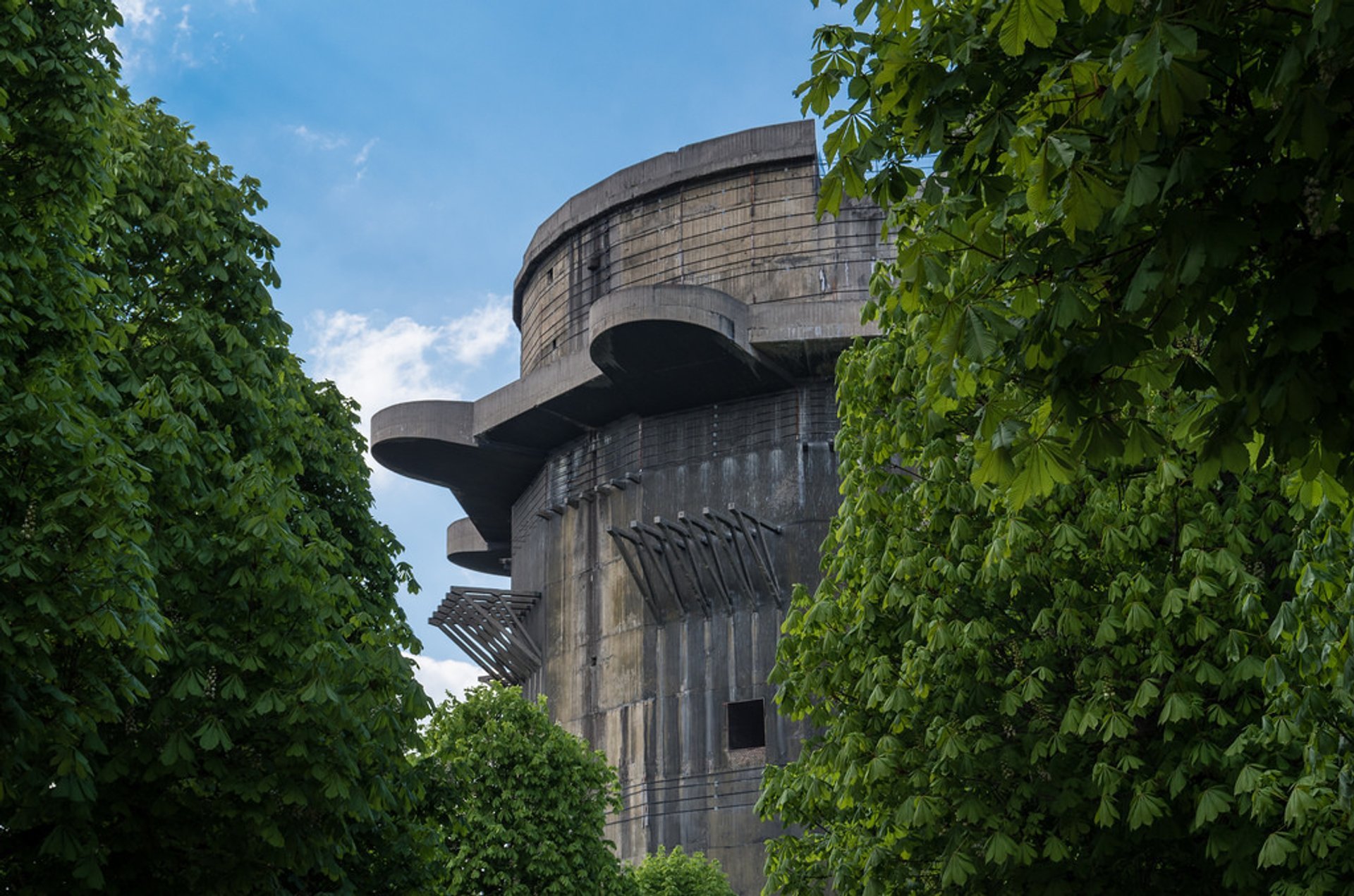Berlin Anti Aircraft Towers - The guns used on the Flak Towers were 128 mm FLAK 40 twin guns. In addition, 37 mm and 20 mm cannons were used for low-altitude defense. They used a unique technique for their guns where they did not try to get a direct shot of the planes.
Instead, they would create a "Flak window" in which they would shoot debris over a 250 by 250 square meter area and use the shrapnel to hit the planes. After the war, French soldiers took down all but two of these defensive structures.
Berlin Anti Aircraft Towers

The two northern towers were spared as demolition was deemed too dangerous. The nearby train tracks to the north were under Soviet administration and damaging them could have sparked a diplomatic situation. The Flak Towers had many other unique features.
The Berlin Flak Tower History
Most of the towers had their own freshwater well, their own power station with underground supplies of fuel, huge storage of ammunition, food and other necessities, their own kitchen, cargo elevators, dormitories and amenities right down to a fully equipped 95-bed
hospital with eight doctors, twenty nurses and thirty aides" ("The Mighty Flak Towers."). They were built to hold up to 15,000 people, but it is reported that 45,000 Berliners were sheltered in one flak tower during The Battle of Berlin.
Today one can go to Berlin, Hamburg, or Vienna to visit or take a tour of one of the Flak Towers used in World War II. If you are interested in touring a Flak Tower, the following link will give you more information: Humboldthain Flak Tower Tour
A few years later, in Allied-controlled Berlin, the Zoo Tower fell under British control. Remembering how the Tower had been built to frustrate their attacks, the British blew it up. This took three attempts with increasing amounts of dynamite.

Eventually, 35 tons of dynamite were able to fell the Zoo Tower. Flak towers (German language: Flaktürme) were 8 complexes of large, above-ground, anti-aircraft gun blockhouse towers constructed in the cities of Berlin (3), Hamburg (2), and Vienna (3) from 1940 onwards.
Other cities that used flak towers included Stuttgart and Frankfurt (Main). After the British Air Force (RAF) had gone on its first bombing run against Berlin in 1940, dropping nearly 200 bombs in the process, Hitler began to reconsider how the Nazis would defend themselves against a competent air force.
They tackled the question in two ways at once. First, they started targeting British cities in hopes of stretching RAF forces thin, and at the same time, they bolstered the capital city's internal defenses. The flak towers had also been designed with the idea of using the above-ground bunkers as a civilian shelter, with room for 10,000 civilians, and even a hospital ward, inside.
The towers, during the fall of Berlin, formed their own communities, with up to 30,000 or more Berliners taking refuge in a single tower during the battle. These towers, much like the keeps of medieval castles, were some of the safest places in a fought-over city, and so the flak towers were some of the last places to surrender to USSR forces, eventually being forced to capitulate as supplies dwindled.
[3] After the RAF's raid on Berlin in 1940, Adolf Hitler ordered the construction of 3 massive flak towers to defend the capital from air attack. These towers were each supported by a radar installation that had a retractable radar dish (the dish was retracted behind a thick concrete and steel dome in order to prevent damage in an air raid).[1]
As World War II approached its end during 1945, the Soviet Army began its advance on Berlin. The Nazis, with their depleted ranks, dwindling supplies, and shattered morale following the suicide of their leader, were not in great shape.

Still, they had a few things in their favor, one of which was the Flakturm Tiergarten, known in English as the Zoo Flak Tower. This tower, containing six levels below the rooftop, includes in its design, as part of its air-raid shelter, two identical spaces for protection against gas attacks, one on the first floor (above ground level) and the other on the second floor
. Both in Tower 1, they are about 300 sq. m. (3,230 sq. ft.) in area, and have six windows (openings in the wall).[4] They were used by the Luftwaffe to defend against Allied air raids on these cities during World War II.
They also served as air-raid shelters for tens of thousands of people and to coordinate air defense. As the Soviets rolled into town, the Zoo Tower's anti-aircraft guns were pointed towards the ground and the Red Army's tanks.
While conditions in the Tower were hardly comfortable, with little room to breathe or water to drink, its defenses held. The guns kept the Soviets at bay, leaving them unable to advance on the Reichstag in open daylight.
The equivalent of a 13-story building made out of reinforced concrete, the Zoo Tower had anti-aircraft guns on its rooftops and an 85-bed hospital on the third floor. At the top, it featured four 12.8-cm twin FlaK 40 mounts, supported by 20 mm and 37 mm guns on lower platforms.
A whole 26 feet (8 meters) of concrete protected the tower's sides and 16 feet (5 meters) protected the top. At full capacity, the Tower could hold up to 350 soldiers and 15,000 people. For a time after the war, the conversion to representative objects with decorated facades was planned.

After the war was lost, the demolition of the towers was in most cases impossible and many remain to this day. The flak towers, the design of which Hitler took personal interest in and even made some sketches for, were constructed in a mere 6 months.
The priority of the project was such that the German national rail schedule was altered to facilitate the shipment of concrete, steel and timber to the construction sites.[2] Both towers were covered over and now appear to be natural hills in Volkspark Friedrichshain.
The G-Tower, known as Mont Klamott (Rubble Mountain) in Berlin, was the inspiration for songs by singer-songwriter Wolf Biermann and the rock band Silly. With concrete walls up to 3.5 meters thick, flak towers were considered to be invulnerable to attack with the usual ordnance carried by Allied bombers, although it is unlikely that they would have withstood Grand Slam bombs which, while not designed for this, had successfully penetrated
much thicker reinforced concrete. [citation needed] Aircraft generally appeared to have avoided the flak towers. The towers were able to sustain a rate of fire of 8000 rounds per minute from their multi-level guns, with a range of up to 14 km in a full 360-degree field of fire.
However only the 128 mm guns had effective range to defend against the RAF heavy bombers. The three flak towers around the outskirts of Berlin created a triangle of formidable anti-aircraft fire that covered the center of Berlin.[citation needed]
The Soviets, in their assault on Berlin, found it difficult to inflict significant damage on the flak towers, even with some of the largest Soviet guns, such as the 203 mm howitzers. Soviet forces generally maneuvered around the towers, and eventually sent in envoys to seek their submission.

Unlike much of Berlin, the towers tended to be fully stocked with ammunition and supplies, and the gunners even used their anti-aircraft 20 mm cannons to defend against assault by ground units. The Zoo Tower was one of the last points of defense, with German armored units rallying near it at Tiergarten, before trying to break out of the encircling Soviet Red Army.[citation needed]
Most people have learned a fair amount about World War II in school, however there is a hidden feature from WWII that most people have never heard of, the Flak Towers. Flak Towers are anti-aircraft defense towers.
The Germans built Flak Towers in Berlin, Hamburg, and Vienna. The Flak Towers of WWII were considered virtually indestructible. The reason they were so durable was their huge size and unique construction. The main towers had a wall thickness of 2.6 meters and a roof 3.80 meters thick, both of which were made of steel reinforced concrete.
They poured all the concrete in one process so there were no vulnerable joints. However, the primary reason they were never destroyed were the huge anti-aircraft guns on top of the towers defending the towers. Of course, a stationary tower with dwindling supplies and a limited reach can only do so much.
Even as the Zoo Tower remained impregnable, the Soviets were able to fly their flag over the Reichstag. The Soviets allowed the troops inside to surrender, although the Nazi command was able to delay the surrender until additional soldiers were able to escape from Berlin.
In 1940, Hitler planned to build six such flak towers. The Humboldthain tower was built between October 1941 and April 1942. It is estimated that it cost about 90 million Marks to build. It took roughly 800 men to build the tower, which consisted of a main G-Tower and a smaller L-Tower.

The G-Tower was the gun tower that was equipped with weapons. The L-Tower was a smaller Flak Tower that functioned as a fire watch and command tower. The walls were up to 2.5 meters thick and the ceiling almost 4 meters thick.
Inside the tower were six levels of air-raid shelter accommodation for around 16,000 civilians. During World War Two the lower floors of the Berlin Flak Tower were used as a bomb shelter for thousands of the city's population.
Visitors are encouraged to wear comfortable shoes and plenty of layers as it can get quite cold (even in summer). Visitors must be at least 14 years of age and under 18's must be accompanied by an adult.
The content of this site is published by the site owner(s) and is not a statement of advice, opinion, or information pertaining to The Ohio State University. Neither text, nor links to other websites, is reviewed or endorsed by The Ohio State University.
What emerged was what civic planners today would refer to as a "mixed use" building. Towers were built with both offensive and defensive capabilities. The Zoo Tower, built in 1941 and named because of its location close to the city's zoo, was among the most prominent of these as explained in .css-3wjtm9{-webkit-text-decoration:underline;text-decoration:underline;text
-decoration-thickness:0.125rem;text-decoration-color:#1c6a65;text-underline-offset:0.25rem;color:inherit;-webkit-transition:all 0.3s ease-in-out;transition:all 0.3s ease -in-out;}.css-3wjtm9:hover{color:#595959;text-decoration-color:border-link-body-hover;}this video about the towers from YouTube channel Real Engineering.
0 Comments